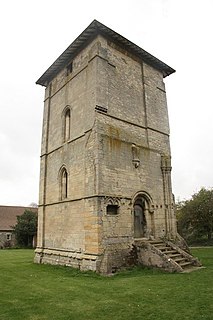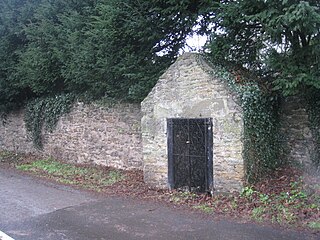
Temple Bruer Preceptory is in a farm-yard in the civil parish of Temple Bruer with Temple High Grange, North Kesteven, Lincolnshire, England. It is one of the few Knights Templar sites left in England where any ruins remain standing. Its name comes from its Templar ownership and its position in the middle of the Lincoln Heath, bruyère (heather) from the French language current at the time. It was founded in the period 1150 to 1160 and the order was dissolved in 1312. The site is at grid reference TF 0085 5370, located between the A15 and A607 roads, 2.5 miles (4.0 km) north from Cranwell. The site has been excavated twice, firstly by the Rev Dr. G. Oliver, the rector of Scopwick in 1832-3, and in 1908 by Sir William St John Hope.
Great Wilbraham Preceptory is a preceptory in Great and Little Wilbraham, Cambridgeshire. Much of the Church of Saint Nicholas at Great Wilbraham dates back to 1226 when a preceptory was established here by the Knights Templar when the manor was given to Alan Martel, who was at that time Templar Master. There is a Templar tombstone hidden away under the tower and a Templar cross on the outside north wall. In the nearby village of Little Wilbraham, at Temple End, an Elizabethan manor house stands on the site of the preceptory. Previous to the ownership of the Templars, the lands were held by monks of Ely. At the dissolution of the Templar order, ownership passed into the hands of the Knights of St John of Jerusalem.

Bottesford Preceptory was sited at Bottesford, just to the south of Scunthorpe, in Lindsey, England. It was on low-lying land, near the Bottesford Beck, about 3 miles (5 km) to the west of the escarpment of the Lincoln Cliff limestone upland, and about the same distance to the east of the River Trent. A preceptory was a community of the Knights Templar who lived on one of that order's estates in the charge of its preceptor. A preceptory also referred to the estate and its buildings. The present Bottesford Manor is believed to have been the gatehouse to the preceptory.

Rothley Temple, or more correctly Rothley Preceptory, was a preceptory in the village of Rothley, Leicestershire, England, associated with both the Knights Templar and the Knights Hospitaller.

Aslackby and Laughton is a civil parish in the South Kesteven district of Lincolnshire, England. According to the 2001 census the parish had a population of 243, in 102 households. increasing slightly to 251 in 118 households at the 2011 census. It consists of the village of Aslackby, the hamlet of Laughton, and scattered farms.

Holy Rood Church, Ossington is a parish church in the Church of England in Ossington, Nottinghamshire.
Stydd Hall (Castle) is a country house located near to the village of Yeaveley, Derbyshire, 15 miles (24 km) west of Derby, close to the A515 between Wyaston to the north, Great Cubley to the south, Yeaveley to the east and Alkmonton to the northeast. Stydd had formerly been an independent township but has all but disappeared: the hall and a farm are all that remains.
Melchbourne Preceptory was a priory in Melchbourne, Bedfordshire, England. It was established in the 12th century and disestablished around 1550.

Shalford Preceptory was a preceptory of Knights Hospitaller at Shalford in the civil parish of Brimpton in the English county of Berkshire. It was established in the late 12th century. By 1338, it had merged with the preceptory at Greenham.
Bulstrode Preceptory was a preceptory in Buckinghamshire, England. It was first mentioned in 1276.
Bodmiscombe Preceptory was a priory in Devon, England. It was ran by the Knights Hospitaller and was possibly founded during the reign on Henry III and dissolved into Buckland Abbey in the 15th century.
Standon Preceptory was a Knights Hospitaller foundation in the parish of Standon, in the county of Hertfordshire, England. It was founded before 1154, probably shortly after the Knights became possessors of the Standon Church in 1151, and dissolved before 1443-4.
Sutton Camera was a priory in Herefordshire, England at grid reference SO52654582.
Great Limber Preceptory, Limber Magna was a Camera (farm) of the Knights Templar and later the Knights Hospitaller in the village of Great Limber, Lincolnshire, England.
Maltby Preceptory was a house of the Knights Hospitaller in the village of Maltby, Lincolnshire, England. There are two differing accounts regarding its history.

Willoughton Preceptory was a holding of the Knights Templar in Lincolnshire, England. The preceptory stood at the farm still called Temple Garth.
Snainton Preceptory was a priory, just south of the village of Snainton, in North Yorkshire, England. The preceptory was started by the Knights Templar at Foulbridge which sits 1-mile (2 km) to the east of a Benedictine Priory at Yedingham. Both houses were on the River Derwent.
Westerdale Preceptory was a priory in Westerdale, North Yorkshire, England. The land was donated to the Knights Templar by Guido de Bovingcourt in 1203, and was one of ten preceptories owned by the Knights Templar in Yorkshire. The Templars worked the land and farmed at Westerdale until their suppression for heresy in 1307-1308.

The site of the former preceptory at Temple Hill, South Witham. It 'has been largely under pasture' since the Knights Templar left in 1308.]] Withham Preceptory, one of the smallest Knights Templar preceptories in England, was founded, before 1164, at Temple Hill, near South Witham, Lincolnshire, and was abandoned in the early 14th century.











